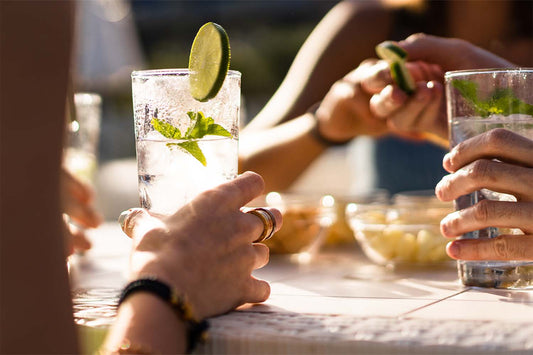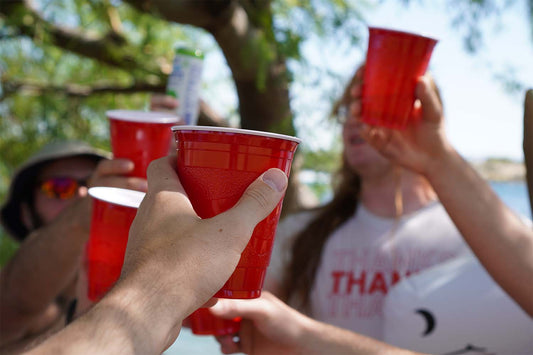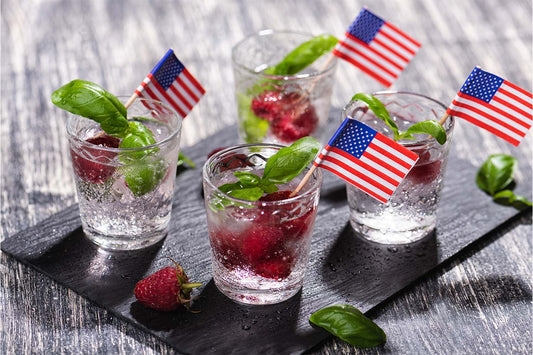You got the home bar of your dreams, and then you realize… You don’t know how to mix drinks. Don’t worry; you’ll learn, and we have some bartending tips that will make your home bar a success (and the envy of your friends).
Know the Basics of Bartending
The best thing you can do as an amateur bartender is to study. It doesn’t sound very exciting, we know, but it’s crucial you understand what you're doing before attempting any type of bartending.
Your studying should go beyond just your favorite recipes. While your favorites are most important, you should see what your loved ones like so you can impress them. To stay organized, you can create a book of recipes with a three-ring binder and printouts.
Here at Haus, we offer a deluxe cocktail kit that you can use as a starting point. The deluxe kit features over 20 recipes and small bottles of Citrus Flower, New Fashioned, Grapefruit Jalapeño, Rose Rosé, Lemon Lavender, and Pomegranate Rosemary. It’s the perfect base to build out the ideal home bar around.
Basic Bartending Terms
- Dash and Splash: This is the smallest measurement. The term is often used for accent ingredients like bitters or club soda.
- Mixers: Any non-alcoholic ingredient added to a mixed drink or cocktail.
- Neat: A drink with no extra ingredients or ice. You’ll most often hear this term used for orders like “whiskey, neat.”
- Up: This is a drink where the glass is chilled with ice, and the ingredients may be shaken or stirred with ice. However, there is no ice within the finished drink.
- Straight Up: This term is similar to up but is generally used only with cocktails and mixed drinks.
- On the Rocks: The drink is served over fresh ice cubes, which are the “rocks.”
- Liquor: A distilled spirit.
- Liqueur: A distilled spirit that is then sweetened. It generally has a lower ABV than liquor.
Cocktails vs. Mixed Drinks
You might be surprised to hear that a cocktail and a mixed drink are two different things.
A cocktail is a combination of liquor(s), bitters, sweeteners, and ice. A mixed drink is anything that mixes two or more ingredients. So a cocktail is more specific than a mixed drink.
Shaken or Stirred
Whether a drink is shaken or stirred is crucial. If you shake when you’re supposed to stir, you’ve ruined the drink, largely because of how much you’re watering it down.
Drinks that are liquor-forward tend to be stirred, while you might shake a drink if you’re incorporating more ingredients.
Keep Your Bar Stocked
What are your favorite drinks? Do you know what they're made of? You need to figure that out and gather all the ingredients before you can start making anything. Then you can display everything nicely and look professional.
Some basic ingredients you should get:
- Cranberry juice
- Orange juice
- Lemon juice
- Simple syrup
- Margarita mix
- Angostura bitters
- Vodka
- Tequila
- Rum
- Whiskey
- Gin
- Apéritifs
- Digestifs
- Sugar
- Salt
- Soda (so kids can join in)
We’re not saying you have to get everything on this list. The best part about having your own bar is that you can customize it to how you want.
You could always ask friends to donate their favorite alcohol or cocktail ingredient to your bar, so it’s on hand for them. You can also throw a Stock the Bar party to debut your bar and get ingredients as gifts.
We also offer a sampler kit if you want to have a little variety in your bar. You get to choose four different apéritifs that sound good to you.
Tools To Get for Your Home Bar
You can’t bartend without the proper tools. Okay, you can, but it will probably make it harder, and you won’t look as classy while you’re bartending.
Mixing Spoon
Why do you need a specific spoon for bartending? Wouldn’t any spoon work?
Yes, technically. You can use any spoon in a pinch, but if you went through all the effort of creating a respectable home bar, why settle?
A drink mixing spoon has a twisted metal handle to help layer cocktails and stir them seamlessly. You can also use a bar spoon as a source of measurement. They tend to be close to a dash.
There are three different styles of mixing spoons: American, European, Japanese.
The American spoon is simple in design with a spiral handle and a red cap at the top. The European has the same spiral handle with a flat disc at the top, often using it as a muddler. The Japanese spoon is longer and slimmer with a teardrop scoop and fork at the top.
Muddler
What is a muddler, and why is it necessary for your home bar?
Muddlers are used to squish juices out of fruits or herbs, which is a key step in making more involved cocktails. The act of muddling also releases the aroma of the ingredients making it a multi-sense experience.
Pro tip: When using a muddler, you squish, not crush, the ingredients. You want the juices, not the particles in your drink.
Shaker
This tool may be the most familiar of all the tools listed here. The shaker is used to shake ingredients together. Usually, it’s the alcohol of your choice with fruits, juices, and ice.
There are three different types of shakers: the Parisian, the Cobbler, and the Boston shaker.
- The Parisian shaker is made up of two parts: the container and the cap. It’s simple, which is great for beginners.
- The Cobbler is made of three parts: the container, a strainer, and a cap. This is a great choice because it lets you skip the straining step when making a drink.
-
The Boston is most popular among professional bartenders. It’s made of two parts that look like a standard cup. Sometimes it’s glass and metal, though more modern versions have both parts made of metal.
One part is slightly bigger than the other, creating a seal that stops the liquid from covering your outfit.
Strainer
This tool is self-explanatory. It allows liquid to go through it while larger ingredients stay within its net.
- The Hawthorn strainer resembles Chinese tea strainers and sits over any glass or shaker. It has a coil around it to catch larger pieces of ingredients like ice.
- A julep strainer is deeper and features very small holes to ensure only liquid goes through.
- A fine mesh strainer tends to be used by professional bartenders and has a funnel shape. Sometimes it’s used as a second strainer to make sure no particles get through.
Jigger
This funny-sounding tool is essential for any beginning bartender. It’s a small container, usually measured, and is two-sided.
It helps with measuring and pouring liquid into the other bar tools. There are many different styles of jiggers: double jiggers, Japanese jiggers, stepped jiggers, and bell jiggers.
- Double jiggers look like an hourglass and are the basic form of this tool.
- Japanese jiggers are slimmer but still have the hourglass shape.
- A stepped jigger is useful for beginners because it has measurements on the outside.
- Bell jiggers have rounded curves and straight rims.
Knife and Peeler
While these tools are more likely to be in your kitchen than your bar, you’ll still need to use them occasionally. It’s mostly for mixer ingredients and garnishes.
Bar Towels
You’re going to make a mess; it’s best to accept that and have bar towels at the ready. Find some in a style you like, and everything can look coordinated.
Corkscrew and Bottle Opener
This is kind of obvious, but you need to be able to open the drinks you’re serving.
Ice Molds
If you really want to look professional, you can invest in special ice molds. The size and shape of the ice change depending on the drink.
This isn't necessary, but it adds a fun flair to your drinks.
Proper Glassware
Part of professional bartending is the presentation, so you need the right glassware.
Be Clean
Another obvious bit of advice: Bartending can get messy, especially as a beginner. Try to clean as you make messes. This will ensure you don’t have any sticky spots or get overwhelmed by the mess at the end of the night.
Learn How To Make Garnishes
As mentioned before, presentation is crucial when bartending, even if you’re only bartending for friends and family. Part of the presentation is the garnish, and you’ll have to know how to make one.
You’ll notice that many cocktail and mixed drink recipes have a citrus garnish. There are a few different ways to make a citrus garnish that will probably require practice.
Other popular garnishes include cherries in some form, like maraschino cherries or brandied cherries, as well as whole herbs.
Are You Feeling a Little More Confident Bartending?
Hopefully, after reading this breakdown of advice, tools, and steps to take, you’re a little more eager to give bartending a try.
Remember that you’ll mess up as you learn, but you can also drink your mistakes so no one will know about them.
Sources:
How to Cut Citrus Fruit Garnishes for Cocktails | The Spruce Eats
How To Stock a Bar Cart | NYMag
Bartending 101: Tips, Tricks, and Techniques for Better Drinks | The Spruce Eats




